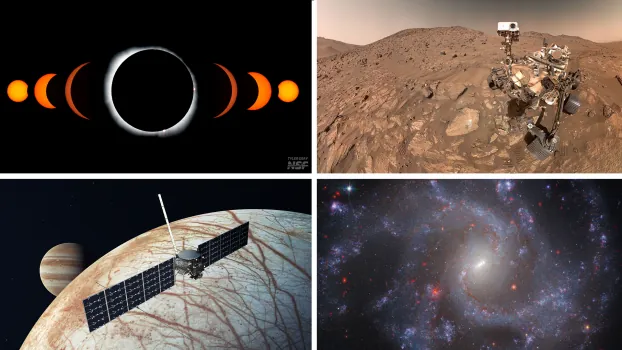
2024 in Space Science: Lunar Ventures, Martian Explorations, and Stellar Discoveries
2024-12-31
Author: Jacob
As we wrap up 2024, it's clear that the field of space science has seen unprecedented activity this year. Notably, three ambitious missions targeted the Moon, while the iconic Mars rovers, Curiosity and Perseverance, continued their groundbreaking explorations on the Red Planet.
Beyond our immediate celestial neighbors, NASA's historic Europa Clipper mission launched towards Jupiter, while Hera embarked on its journey to assess the impact left by the DART mission in 2022. The Parker Solar Probe made its closest approach to the Sun yet, and the Voyager spacecraft continued to send data from the vast reaches beyond our solar system, despite some technical challenges.
The Americas were treated to two spectacular solar eclipses in 2024: a total eclipse sweeping across North America in April, followed by an annular eclipse visible in parts of South America in October. The year also witnessed extreme solar activity, leading to mesmerizing auroras that graced even lower latitudes.
Breakthroughs in X-ray Astronomy
2024 marked a significant year for X-ray astronomy. The Japanese X-Ray Imaging and Spectroscopy Mission (XRISM) telescope released its first images in January, showcasing the power of soft X-ray imaging. Later, more missions like the Einstein Probe and Space Variable Objects Monitor (SVOM) X-ray telescopes launched, expanding our observational capabilities. However, budget cuts loomed over NASA's Chandra X-ray Observatory, raising concerns about the continuation of its invaluable mission.
New Lunar Missions Launched, Landed, and Canceled
The year kicked off with Astrobotic's Peregrine lunar lander launching atop a ULA Vulcan rocket on January 8, aiming to deliver up to 100 kg of payload to the Moon. Unfortunately, despite a successful launch, Peregrine did not reach the Moon and reentered Earth’s atmosphere due to a malfunction in its helium pressure control valve, leading to the loss of its oxidizer tank.
In a twist of perseverance, the Japanese SLIM lander touched down on the Moon shortly after, demonstrating its precision landing capabilities, despite landing in a less than ideal orientation. Nevertheless, it collected valuable data from the lunar surface before losing contact in late April after surviving three lunar nights.
Intuitive Machines' Nova-C lander, which became the first commercial lander to touch down on the Moon, also faced challenges when it tipped over shortly after landing. Meanwhile, China's Chang'e 6 mission achieved a historic milestone by returning samples from the far side of the Moon, enriching our understanding of lunar geology.
Martian Discoveries by Rovers
Mars remained a focal point for exploration with NASA's rovers Curiosity and Perseverance making significant discoveries. Curiosity unearthed pure sulfur rocks, affirming the presence of elemental sulfur that likely points to ancient water activity on Mars. Meanwhile, Perseverance's examination of a rock named “Cheyava Falls” revealed organic compounds hinting at the building blocks of life, further fueling the search for extraterrestrial life in our solar system.
Expanding the Knowledge of Our Solar System
Notably, ESA's Hera mission launched to investigate the binary asteroid system Didymos and Dimorphos, following the successful DART mission that altered Dimorphos' orbit. The highly anticipated Europa Clipper began its journey toward Jupiter to analyze the ocean beneath Europa's icy shell, aiming to determine its potential for hosting life.
Additionally, probes like JAXA's BepiColombo faced challenges but continued to provide valuable data regarding Mercury, while Parker Solar Probe set new records for proximity to the Sun and speed.
Groundbreaking Observations with Hubble and Webb
The Hubble Space Telescope and the James Webb Space Telescope continued to astound us with their discoveries. Hubble observed distant exoplanet weather patterns, while Webb provided evidence for the existence of a neutron star in a supernova remnant. Their combined efforts advanced our understanding of the universe's early galaxies, unveiling insights into the birth and evolution of cosmic structures.
What's on the Horizon for 2025?
As we look towards 2025, anticipation builds for a series of lunar missions, including a planned attempt at landing by Firefly Aerospace's Blue Ghost lander and the second Hakuto-R mission from ispace. Alongside these, more missions are poised to deepen our understanding of Mars and the Sun, paving the way for future explorations.
With so much on the horizon, space science enthusiasts and professionals alike can only imagine what groundbreaking discoveries await us in the coming year. This past year has set an incredible stage for innovations and discoveries that could redefine our understanding of the cosmos.



 Brasil (PT)
Brasil (PT)
 Canada (EN)
Canada (EN)
 Chile (ES)
Chile (ES)
 Česko (CS)
Česko (CS)
 대한민국 (KO)
대한민국 (KO)
 España (ES)
España (ES)
 France (FR)
France (FR)
 Hong Kong (EN)
Hong Kong (EN)
 Italia (IT)
Italia (IT)
 日本 (JA)
日本 (JA)
 Magyarország (HU)
Magyarország (HU)
 Norge (NO)
Norge (NO)
 Polska (PL)
Polska (PL)
 Schweiz (DE)
Schweiz (DE)
 Singapore (EN)
Singapore (EN)
 Sverige (SV)
Sverige (SV)
 Suomi (FI)
Suomi (FI)
 Türkiye (TR)
Türkiye (TR)
 الإمارات العربية المتحدة (AR)
الإمارات العربية المتحدة (AR)